 What happens when people realise there is only so much the Earth can take and they have been really imprudent in defacing the environment for so long? What happens when they stare at the energy crisis in the face and feel it might be a wee bit late for damage-control? Let me try answering these thought-provoking questions..
What happens when people realise there is only so much the Earth can take and they have been really imprudent in defacing the environment for so long? What happens when they stare at the energy crisis in the face and feel it might be a wee bit late for damage-control? Let me try answering these thought-provoking questions..
Energy-conscious programs at the forefront
Missions like the Renewable Energy Target (RET)come into the forefront, energy-generating programs begin, and green architecture becomes the mantra. The last one in particular is bringing in a lot of enthusiasm today. The rules are simple. We have to become energy sustainable and pretty quickly at that. Our homes have to be built on the ‘green’ principles. Period!
Sustainable home designs
So, what do we really mean by energy sustainable homes? Simply put, they are the kind of homes that generate more electricity than they consume. And you may ask how can this be attained? I will use the remainder of this article to answer just this.
Sustainable building programs, building materials, and building designs can together make a home energy-sustainable.
Rooftop solar projects and their likes
A good shot at sustainability which comes to mind immediately is the Rooftop Solar project that has been so well lapped up by America. Do we lack sunlight? No! So what’s stopping us from initiating such programs in a big way ourselves. There is not much to it unless you think placing solar panels on your rooftop is a futuristic idea.
‘Feed-in tariff’ and ‘export tariff’ programs
Solar panels can be a fair bit of one-time cost, but they more than offset this cost in due course of time by the kind of energy they save. I think the feed-in-tariff program which allows you to personally use electricity generated by your solar panels can go a long way in making your home sustainable. Add to this, programs like the export-tariff program which permit you to sell extra electricity that you generate back to the grid. I don’t need to tell you how this can help your wallet.
The central idea, which is not tough to guess, is that such programs can help us generate more energy than we consume. Is it not what I mentioned energy sustainability is all about?
Sustainable building materials
For sustainable building materials, you do not need to look beyond eco-friendly materials like natural linoleum, fleece, cork, bamboo, and low-VOC paints. These are non-toxic, fairly biodegradable (most of them) and can be recycled at will. These, unfailingly reduce the impact on the environment and boost our ‘green’ resolution.
Sustainable building designs
While designing buildings today, home designers look at how the entire structure supports the cause of eco-friendliness. Roof adobes, wooden or aluminium sidings, low-flow plumbing equipment, and energy-rated appliances can be a great aid in the save-energy crusade.
Of course, if you can spend a little generously, you can also seek succour from tools like the learning thermostat, LED lights like Alba and Hue, and a wide range of ventilation optimisers. They can help you limit energy wastage a great deal.
Sustainability is possible, but only if we take it seriously
Sustainability is possible, and green architecture can contribute handsomely towards it. People are making the right moves. I don’t think ambitious projects like the vertical forests (they reduce Sick Building Syndrome and improve indoor air quality) would have been possible if people were not turning over a new ‘energy’ leaf. It is just that when it comes to our environment, no caution and no ambition may be good enough. Miles to go still!
If you are looking to build a green home for yourself, I will be delighted to give a hand. You can get in touch with me here.

